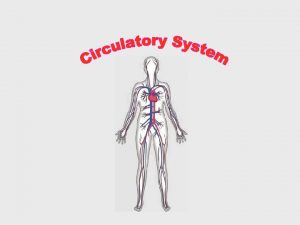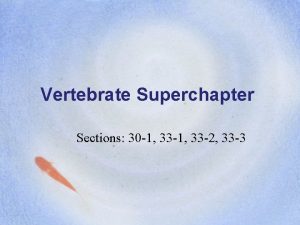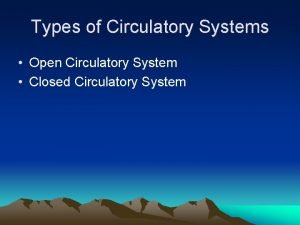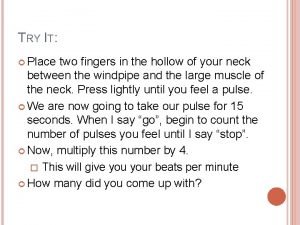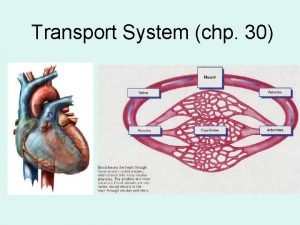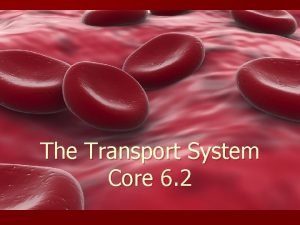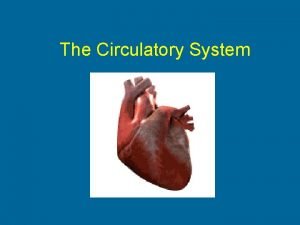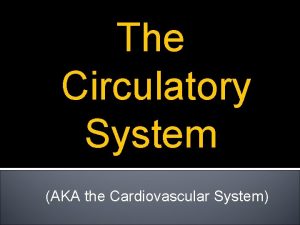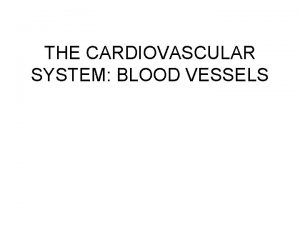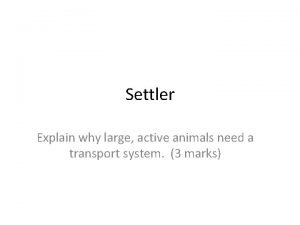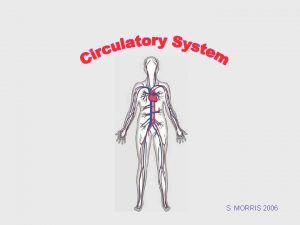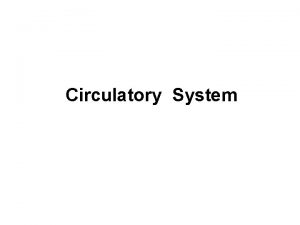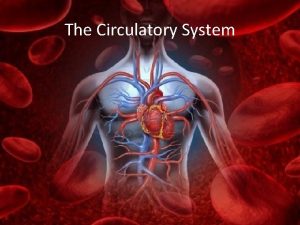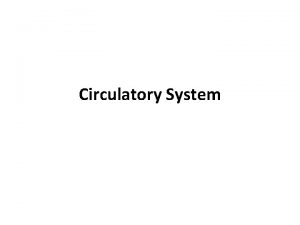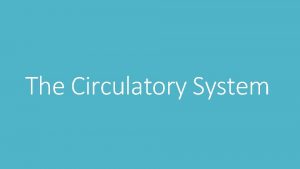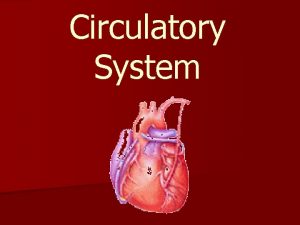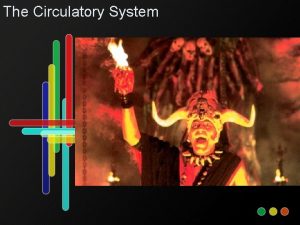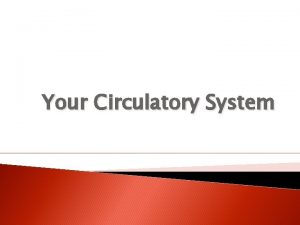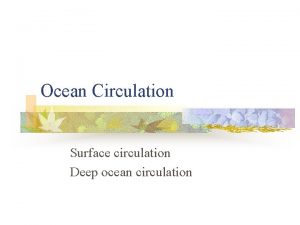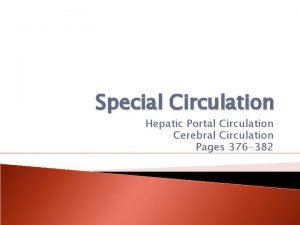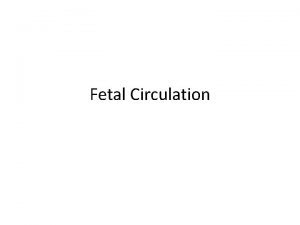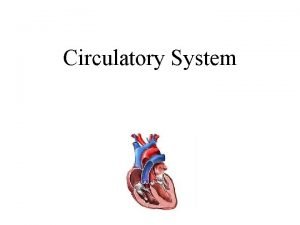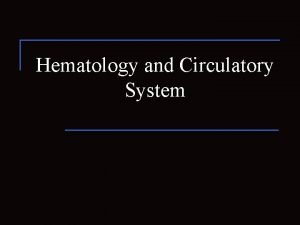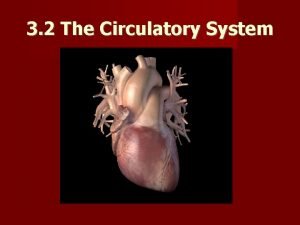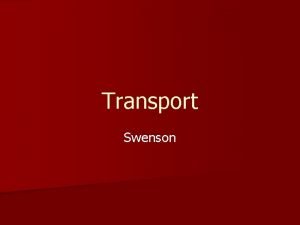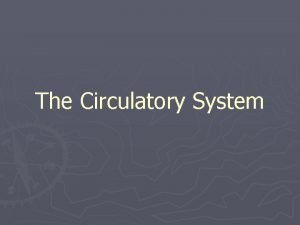CIRCULATION Ch 11 Process of Circulation q Circulatory


















- Slides: 18

CIRCULATION Ch 11

Process of Circulation q � Circulatory System �Blood Vessels �Heart Purpose: � 1) To deliver oxygen, water and food to the body � 2) To remove waste such as Carbon Dioxide

Does everyone have one? � Not all animals have circulatory systems �Simple animals Sponge, sea anemone and hydra �Their bodies are only a few cells thick �Water flows freely �Oxygen and nutrients diffuse from the water to the body

Not all the same! � � Some animals have a closed circulatory system �Worms This means blood flows through tubes

� � Some animals have an open circulatory system This means their blood flows freely through the body

Structure of the Heart � � � Divided into right and left Each side has a small chamber on the top (atria) And a large chamber on the bottom (ventricles)

How the heart pumps � � Resting heart rate is 60 to 80 beats per minute Running heart rate is up to 150 times per minute! Will pump more then two billion time in your lifetime Structure of the heart allows blood to only flow in one direction.

One directional movement � � � Artery – carries blood AWAY from the heart Vein -- carries blood TOWARD the heart Needs Valves �Flaps in the heart that keep blood flowing in one direction

Types of Valves Tricuspid valve -- valve between the right atrium and right ventricle. • Bicuspid valve (mitral) – valve between the left atrium and left ventricle. • Semilunar valve – are located between the ventricles and their arteries • Valves closing are what causes your heart beat •

Right side � � � 1) Blood enters the right side of the heart at the right atrium via the vena cava (largest vein in the body) �Little oxygen at this point 2) Pumped to right ventricle 3) Pumped to pulmonary artery – carries blood to lungs

Right side cont. � 4) Blood enters both lungs �Blood picks up oxygen here �Blood loses carbon dioxide here – now bright red 5) Returns to the heart through pulmonary veins Left side Takes less then 10 seconds for blood to go from heart to lungs

Left side � � � 1) Blood rich in oxygen arrives at the left atrium 2) Left atrium to left ventricle 3) Blood pumped from the ventricle to the large aeorta 4) Blood goes to body parts 5) Goes back to the heart (right side) is once again blue.


Arteries � � � Carry blood away from heart Blood is squeezed into artiries �Blood pressures �The force created when blood pushes against the walls of vessels Important traits �Carry blood away from the heart �They carry blood under high pressure

veins � � � Bring blood to the heart Less muscular than arteries, flatter and wider Many valves Under low pressure Carry blood to heart, carry blood under low pressure, flat with little muscle, many one-way valves.

Capillaries � � � Smallest kind of blood vessel. One cell thick. Thinner than a page in a book. More capillaries than any other blood vessel. Bring blood close to all body cells. All gas exchanges occur in capillaries.

Problems � � High blood pressure – hypertension – caused partially by cholesterol. Heart attack – blood vessels that carry blood to and from heart are called coronary vessels. Heart attack is the death of heart muscle. Avoid problems: �Eat well �Exercise

Facts � In 2005, 652, 091 people died of heart disease (50. 5% of them women). This was 27. 1% of all U. S. deaths. � Heart disease is the leading cause of death for American Indians and Alaska Natives, blacks, Hispanics, and whites. For Asians and Pacific Islanders, cancer is the leading cause of death (accounting for 27. 5% of all deaths), heart disease is a close second (25. 0%). � Worldwide, coronary heart disease killed more than 7. 6 million people in 2005.
 Single circulation and double circulation
Single circulation and double circulation Single circulation and double circulation
Single circulation and double circulation Bronchiole
Bronchiole Circulatory system steps in order
Circulatory system steps in order Single loop circulatory system
Single loop circulatory system Lungfish heart
Lungfish heart Does a clam have an open or closed circulatory system
Does a clam have an open or closed circulatory system Horse heart
Horse heart Function of the circulatory system
Function of the circulatory system Closed circulatory system
Closed circulatory system Jobs of circulatory system
Jobs of circulatory system 3 parts of the circulatory system
3 parts of the circulatory system Major arteries and veins of the systemic circuit
Major arteries and veins of the systemic circuit How respiratory system work with circulatory system
How respiratory system work with circulatory system Active animals
Active animals How circulatory system work
How circulatory system work What makes up the cardiovascular system
What makes up the cardiovascular system The actual exchange of gases occurs at the site of the *
The actual exchange of gases occurs at the site of the * Phylum arthropoda marine
Phylum arthropoda marine



